Advocates Celebrate Slow Lake, but Questions Remain
4:06 PM PST on December 12, 2022
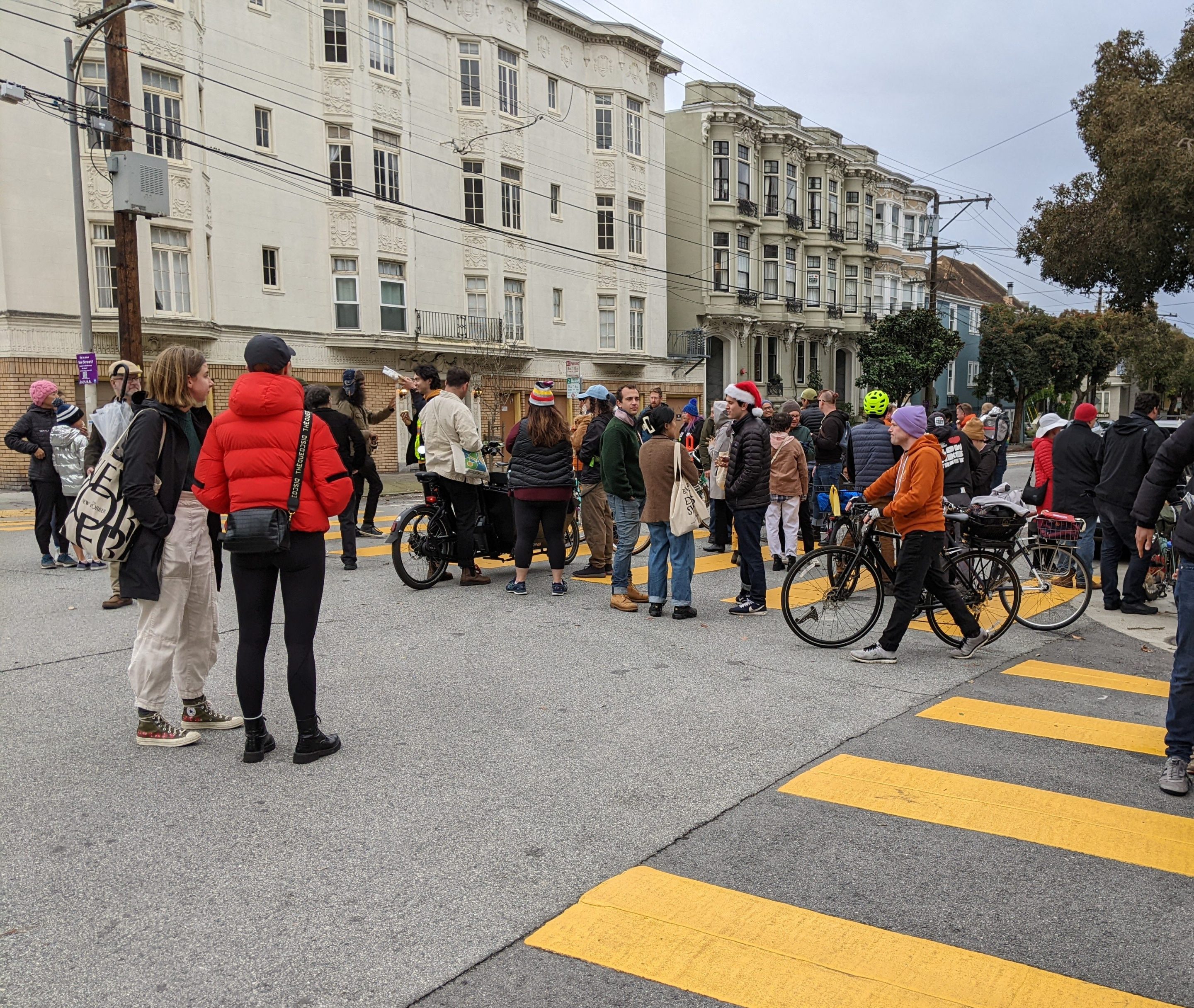
Some 35 advocates got together for a walk down Slow Lake on a wet Sunday afternoon. Photo: Streetsblog/Rudick
Note: GJEL Accident Attorneys regularly sponsors coverage on Streetsblog San Francisco and Streetsblog California. Unless noted in the story, GJEL Accident Attorneys is not consulted for the content or editorial direction of the sponsored content.
Some 35 advocates, families, and neighbors assembled for a celebratory walk and ride down Slow Lake Street in the Richmond District on a rainy Sunday afternoon. Just last week, at a contentious public hearing that went late into the night, the SFMTA board voted to include Lake among its sixteen permanent "Slow Streets."
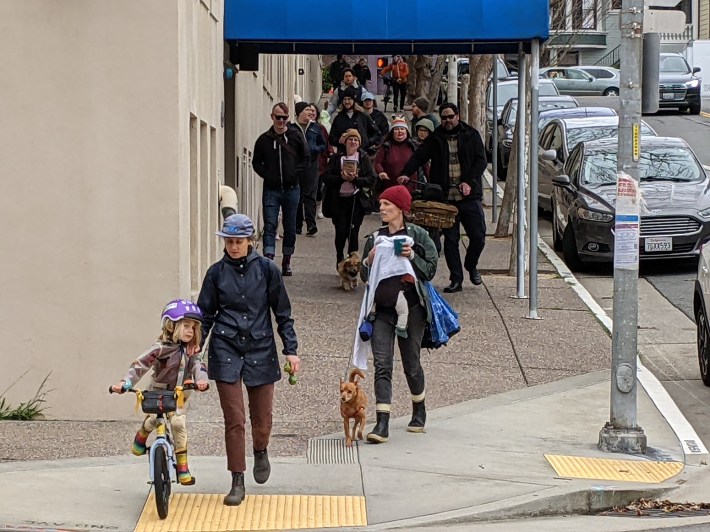
While the mood was generally festive--lots of people brought yummy cookies to the event--there were also big questions. For example, what happened to the signs that blocked through traffic, which were installed when Slow Lake was created During the COVID crisis? Those signs were removed last week prior to the vote and not immediately replaced. This lead to confusion; it also encouraged motorists to use Lake, once again, as a high-speed cut through, as seen in this tweet from safe-streets organizer and advocate Luke Bornheimer:
Meanwhile, opponents of Slow Lake are running stop signs and driving 40+ mph for multiple blocks to show their defiance (and highlight the inadequate infrastructure that’s installed on the street).
— Luke Bornheimer (LukeBornheimer@sfba.social) (@LukeBornheimer) December 11, 2022
All Slow Streets must have traffic diverters to stop this dangerous behavior now. pic.twitter.com/faDwKsuZDm
The older, a-frame signs might not have stopped the reckless driver seen in that tweet, but at least they would have made driving like that a bit more difficult. SFMTA has started to replace signs with bendy posts, but they are typical city signage that seems engineered for one sole purpose: to avoid damaging people's cars if they run over them.
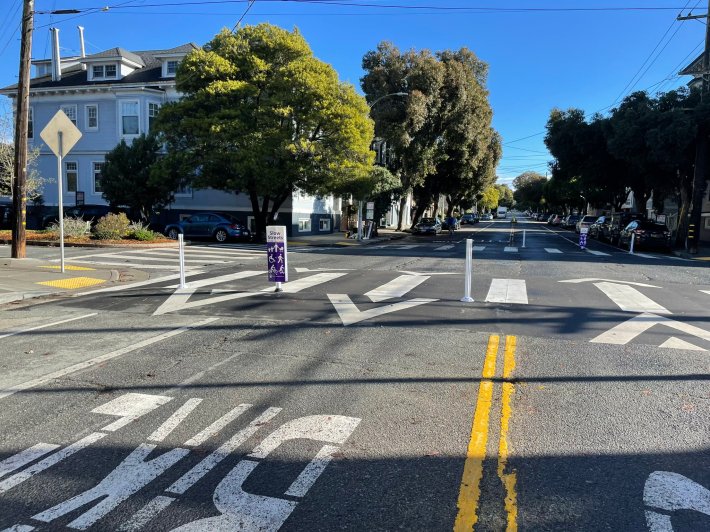
So why did SFMTA remove the older signs prior to the vote? SFMTA's media affairs department only said that the signs were old and "outdated." However, a source at SFMTA told Streetsblog the agency realized prior to Tuesday's vote that it would be necessary to either remove the Slow Streets signs permanently or replace them with something other than "road closed" signs, so they figured they might as well get the removals done.
Unfortunately, the majority of the new signs aren't even in the street, and instead are attached to poles on the sidewalk where they are unlikely to be seen by motorists, depending what languages they can read:
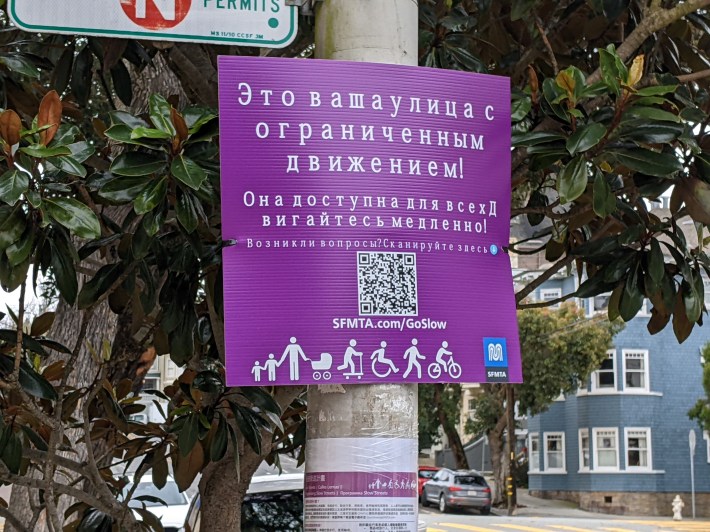
They also don't clearly state that through traffic is banned, which means SFMTA is already watering down the Slow Streets concept on Lake--and started doing so prior to last week's vote. It's unclear how this was authorized, since it obviously didn't come from the board of directors.
As a result of this, some advocates have started to bolster the installations on their own, as seen below (note the bucket of concrete at the bottom):

They've also been putting back the "local traffic only" signs, countering the city's watering down of the whole plan. More on the signs that were bolstered by residents and advocates in this tweet below:
On Tuesday 12/6 @SlowLakeStreet was approved as a permanent Slow Street. On Wednesday 12/7, we received word that the Mayor's Office wanted to delay installing new Slow Street signage.
— Parker Day (@desertflyer) December 12, 2022
Instead of waiting, the community reacted. If the city won't put up Slow Street signs, we will pic.twitter.com/CE7CYVoTKW
SFMTA's little plastic bendy straws bolted directly to the asphalt are an incredibly inadequate and dangerous way to "protect" a Slow Street, since they don't actually offer any protection. Bornheimer and others hope to see long-term upgrades made as well as the installation of proper bollards and concrete diverters, as explained in his excellent thread below:
Not only are the official delineators and signs installed far enough apart so as to allow cut-through traffic to continue using Slow Lake without being diverted, the infrastructure is inadequate at eliminating cut-through traffic.
— Luke Bornheimer (LukeBornheimer@sfba.social) (@LukeBornheimer) December 12, 2022
The City needs to install traffic diverters now. https://t.co/FBzGbinHjz pic.twitter.com/A5SJ8Kjsd0
More evidence below that a percentage of motorists will simply do whatever they want when there is no physical infrastructure to stop them, as seen Sunday afternoon (and every day of course):
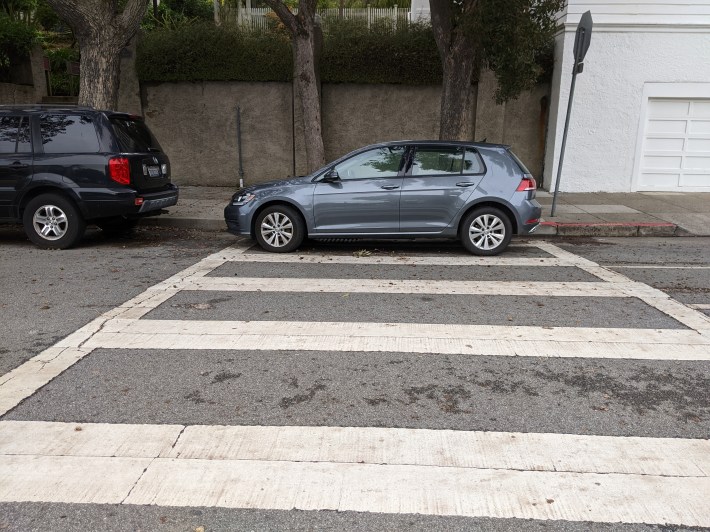
Stay in touch
Sign up for our free newsletter
More from Streetsblog San Francisco
Weekend Roundup: Bancroft Lane Gets Concrete, Party in Downtown S.F.
...and the Bay Bridge to get its lights back
Richmond-San Rafael Bridge Bike Lane Will Need Support
There's no evidence the bike lane contributes to congestion on the bridge
Update on Oakland DOT’s Lakeshore Protected Bike Lane Project
Public seems fairly positive and accepting towards the coming project. Let's hope it stays that way




